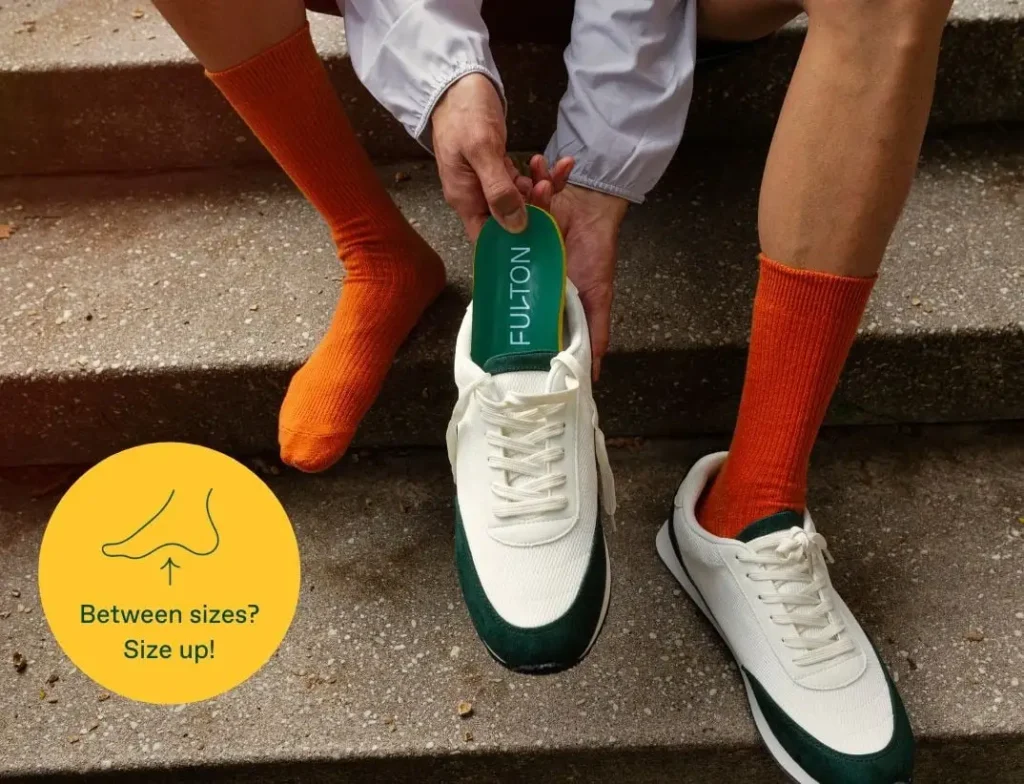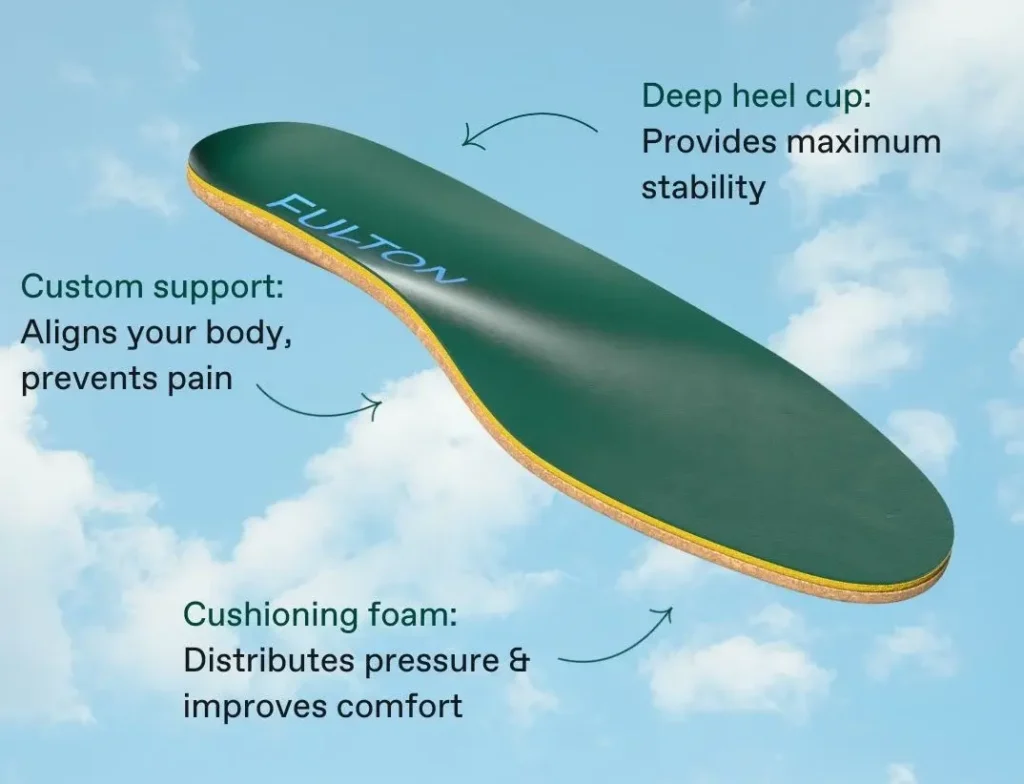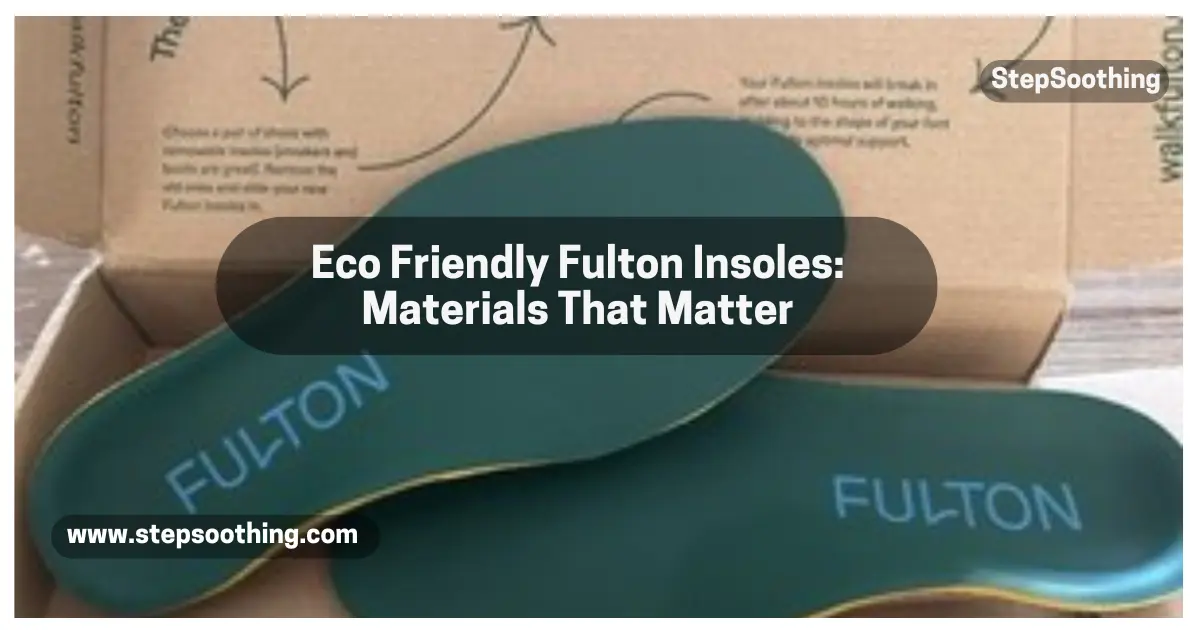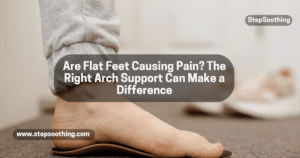Are your insoles helping the planet or hurting it? In today’s eco conscious world, Fulton insoles materials stand out for offering both sustainability and comfort. These aren’t the usual plastic foam inserts they’re built from natural, plant-based components designed to support your feet and reduce environmental impact.
From a cork base that molds to your foot to organic cotton that keeps things fresh, each layer in Fulton’s design serves a purpose. This article explores exactly what goes into Fulton’s eco friendly insoles and why these sustainable materials are changing the game in foot health and performance.
What Materials Are Used in Fulton Insoles That Make Them Sustainable?

Materials Make Fulton Insoles Sustainable?
What makes Fulton insoles different is the way each layer is crafted from natural, eco conscious materials without compromising performance. At the core lies a custom-molding cork base that adapts to your foot shape, providing structured arch support and reducing joint strain from the ground up. Unlike synthetic foam used in standard shoe inserts, this cork base naturally molds to the curves of your arches and heels, distributing pressure and promoting healthy alignment over time.
Layered above that is resilient foam made from natural latex, offering gentle cushioning for both walking and high impact activity. The top cover? That’s where organic cotton steps in soft, breathable, and treated with antimicrobial technology to stay cool, odor-free, and dry during daily wear. Together, these materials create one of the most comfortable and supportive foot insoles I’ve worn, whether I’m in sneakers, boots, or lifestyle shoes.
How Fulton Uses Plant Based Materials for Sustainability
When you think about eco friendly insoles, Fulton stands out as a brand built on reducing waste and minimizing environmental impact. Their entire process uses plant based inputs no plastic, no petroleum based foam, and a clear focus on carbon negative manufacturing. The natural cork, latex, and organic cotton are all renewable, biodegradable, and harvested using sustainable methods that support long term ecosystem health.
Compared to mass produced insoles that end up in landfills, Fulton’s approach feels like a step in the right direction. From sourcing to packaging, everything is designed to reduce excess and help the planet. Even the way their custom molding cork helps with long run durability means fewer replacements, less waste, and more thoughtful design. If you’ve ever had concerns about your footwear’s role in climate change, this is a brand that’s trying to align sustainability with foot health.
Health Benefits of Fulton’s Eco Friendly Materials
Since switching to Fulton, I’ve noticed how the custom arch support made from cork gently stabilizes my feet without feeling rigid. It actually helps with plantar fascia strain and heel pain, especially if you have flat feet, high arches, or deal with overpronation. The material conforms slowly, improving posture, easing back tension, and preventing future foot injury by keeping your body aligned during movement.
The cotton top layer adds more than just comfort it helps manage moisture, reduces irritation, and stays fresh even when you wear it for up to 10 hours a day. Paired with antimicrobial properties in the latex foam, these insoles keep your feet protected and free of odor, especially when used in athletic sneakers, work boots, or running shoes. It’s rare to find insoles that work well in both casual footwear and athletic activity, but Fulton really delivers.

Fulton Insoles vs EVA Foam: A Material Breakdown
| Feature | Fulton Insoles | Generic Insoles (EVA Foam) |
| Core Material | Moldable Cork | Ethylene-Vinyl Acetate (EVA) |
| Cushioning Layer | Natural Latex Foam | Polyurethane Foam |
| Top Cover | Organic Cotton | Polyester or Nylon Fabric |
| Eco Impact | Carbon Negative, plant-based | Plastic-based, high footprint |
| Durability | 500 miles of regular wear | Medium lifespan, flattens quickly |
I’ve tried both, and the difference is like walking on clouds with Fulton versus bouncing on synthetic pads that lose shape. With Fulton Classic Insoles, I experienced long term benefits without the need to constantly replace them. That’s a major support both for my feet and the environment.
Ethical & Sustainable Sourcing Behind Fulton Insoles
One thing I love about Fulton is how transparent they are. The cork comes from Portugal, where it’s harvested responsibly without harming trees. Natural latex is tapped from ethical sources in Asia, where trees are protected and labor conditions meet high standards. Their organic cotton is grown without harmful chemicals, making the top layer not only safe but great for people with skin sensitivity.
This careful attention to sourcing reflects in the quality of the product. Each pair feels like it was made for your foot, thanks to how well the materials are handled before they reach you. And because the supply chain is traceable, you know exactly what you’re stepping into literally.
Are Fulton Insoles Safe for Sensitive Skin & Allergies?
If you’ve ever had reactions to synthetic insoles, you’ll be happy to know that Fulton insoles are made with toxic free materials. While they do use natural latex, most people won’t experience irritation because the latex layer is enclosed and doesn’t come in direct contact with the foot. The cotton top cover is also hypoallergenic, smooth, and cool to the touch, even in higher impact conditions.
Still, if you’ve been diagnosed with a latex allergy, it’s smart to consult a healthcare professional before use. Fulton doesn’t use harsh adhesives or chemical based foam, which means you’re less likely to encounter the kind of foot discomfort or irritation that sometimes comes from ill-fitting shoes or synthetic liners.
Fulton’s Mission: Eco Friendly Materials with Purpose
It’s clear that Fulton is focused on more than comfort they want to support your foot health while protecting the planet. They’ve said from the start that their mission is to make custom molded, supportive, and sustainable shoe inserts for everyday wear. The use of custom molding cork, organic cotton, and natural latex reflects a choice to prevent waste, avoid petroleum based plastics, and help users feel the difference from day one.
This material mix isn’t just eco conscious it improves the functionality and performance of the insoles. Whether you’re walking 30 miles a week or standing 8–10 hours a day, the materials work together to relieve pain, reduce fatigue, and lift your stride in a way synthetic brands just can’t match.
Fulton Insoles Durability vs Synthetic Alternatives
In my experience, Fulton insoles hold their shape even after months of daily wear. Thanks to the durable cork foundation, they remain supportive, don’t compress easily, and continue to offer a personalized fit for up to 500 miles. I’ve worn the same pair across different shoes, from loafers to hiking boots, and the performance hasn’t faded.
Compare that to memory foam or gel-based options, which tend to tear, flatten, or retain moisture after a few weeks. While those might feel good on day one, Fulton’s custom molding gets better with time. That makes it an ideal choice for the long run, especially if you’re balancing work, errands, and fitness.
Can Fulton Insoles Be Recycled or Composted?
Yes, the materials used in Fulton insoles are designed with the end of life in mind. The cork base and organic cotton top layer are biodegradable, making them suitable for industrial composting under the right conditions. While they may not fully break down in a home compost bin, the absence of plastic and petroleum based foam means they create far less waste than typical synthetic insoles.
Fulton is also exploring future options for recycling programs through walkfulton.com, where users may be able to return worn out pairs for responsible disposal. It’s this kind of sustainable thinking that sets them apart from other brands. Even if you wear them for months, knowing they won’t end up polluting landfills adds an extra layer of confidence and commitment to buying eco friendly insoles.
Real User Feedback: Comfort of Fulton’s Natural Materials
The feedback from real users speaks volumes. From day one, many notice a difference in how their feet, knees, and back feel especially after walking or standing for hours. Whether you’re tackling a 10-hour work day, going for a hike, or just doing day to day casual walking, the custom molding cork base, massaging foam, and organic cotton layer work together to provide supreme comfort and help reduce fatigue and joint strain.
Users like Kendyl F. and others say these insoles made a difference in their stride, posture, and even helped relieve pain linked to overpronation and plantar fasciitis. I’ve worn mine in athletic sneakers, running shoes, and boots and whether I was hitting the gym or running errands, I felt the padding adapt to my foot shape without causing discomfort. It’s rare to find an insole that stays comfortable, odor free, and secure after miles of wear, but Fulton nails it.
conclusion
The secret to Fulton’s performance and sustainability lies in the Fulton insoles materials a carefully chosen mix of cork, organic cotton, and natural latex. These elements not only provide long-term comfort and arch support but also ensure minimal environmental harm.
Whether you’re walking miles, standing all day, or just trying to reduce waste, Fulton insoles offer a smart, sustainable solution. By choosing materials that are renewable, biodegradable, and foot friendly, they help you make every step count—for your health and the planet.



